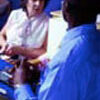Return of the Master Detectives
While many of you associate me with hospital medicine and SHM, this is only my latest incarnation. For more than 15 years I was a practicing solo general internist in Southern California. You remember me as one of those local medical doctors (LMDs), who stopped by the hospital on the way to their office in the tall office building next to the community hospital where they worked from 9-12 and 2-5 and then went back to the hospital to see admissions and do consults for surgeons.
Right out of training in the 1970s I was the complete internist. I managed my own vents, did my own lumbar punctures, bone marrows, and arterial lines. I prided myself on being well versed in enough of the medical specialties that I was my own internal consultant and the first line of consultation and advice for local surgeons and family practitioners (FPs).
I should also reveal that I played a role first on the board of directors of the American Society of Internal Medicine (ASIM) and then on the board of regents of the American College of Physicians (ACP). I was in the vicinity when RBRVS (resource based relative value system) was born and when internists devolved into gatekeepers and primary care physicians.
I saw the internist as the master detective, but somehow we were recast as the cop on the beat very much on the front lines. From solving the great mysteries we were now settling domestic squabbles and writing traffic tickets. OK we were filling out forms for durable medical goods and writing prescriptions for antidepressants.
General internal medicine had a chance to define itself as comprising physicians who were master diagnosticians, the only doctors capable of handling the complexities of comorbidities, especially in the aging population. Instead of seizing terrain that was so uniquely geared to internal medicine training and experience, internists decided to compete with FPs and nurse practitioners (NPs) to be the traffic cop for resource use and burgeoning specialization.
Internal medicine has always been at a monetary disadvantage to the technospecialties of procedures and gadgets. But at least in the pre-primary care physician (PCP) world, internists could boast they were the “doctors’ doctors,” ready to take on the difficult and the complex. When we cast our lots with the gatekeepers, we became pieceworkers and paper shufflers. We made the excitement of internal medicine—the use of our skills of diagnosis and information integration—something to be avoided because of their very complexity. We created a situation in which the patients who most needed our services were disadvantageous in a world that devalued our training and wanted us to be more like the practical and efficient NPs.
Hospital medicine has come along to tap into the skills of internal medicine in the acute care setting. Hospital medicine strips away the PCP and gatekeeper functions, leaving us with the core of what drew many of us to internal medicine in the first place. As hospital medicine attempts to evolve into what the health system and our patients need, there are glimpses of what a “new” internist might be.
Clinical knowledge and bedside skills are still in demand. The ability to integrate information and see through complexity to formulate a diagnostic plan and a treatment protocol still define internal medicine. But the skills for the 21st-century internists now include data collection, quality improvement, systems analysis, teamwork, management, and leadership.






